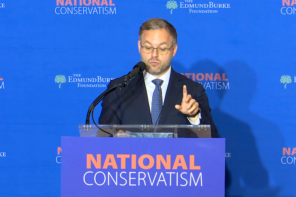At a Monday Town Hall meeting in Howard, Wisconsin, Mitt Romney tried out new tactical skills as he fielded the kinds of sticky questions about LDS doctrine Mormons are bracing for this campaign season.
A Ron Paul supporter in the audience, reading from typed notes, quizzed Romney on whether or not he subscribed to a verse of LDS scripture that correlated phenotypic and spiritual darkness and whether or not he opposed interracial marriage, as did LDS Church leaders down through Spencer Kimball (who died at the age of 90 in 1985).
Predictably, Romney got a bit prickly. But he also applied what appeared to be a new rhetorical strategy, telling the Paul supporter that he would not discuss the “doctrines of my religion” but that he would discuss the “practices of my faith,” and then using the moment to pivot to a discussion of his service as a lay pastoral leader.
For Romney, “doctrines” versus “practices” is a perfectly workable distinction, one that reflects the pragmatic core of modern Mormonism as well as the rather fluid and uneven state of its theology.
Mormonism has no professional clergy, no theological-scholarly corps. There is no regularly recited doctrinal creed. For well over a hundred years the tradition has been conveyed by word-of-mouth in thousands of lay-taught Sunday School classes and around kitchen tables and campfires. A correlated, cradle-to-grave curriculum was developed in the 1950s, but beyond central tenets of what Mormons might call “the gospel”—faith in Jesus Christ, repentance, baptism; the inspired origins of the LDS Church and Mormon scripture; the eternal significance of families—Mormonism remains a theological “jungle,” as one eminent LDS scholar put it.
Take, for example, the Church’s teachings on race. Controversy flared in February when BYU religion professor Randy Bott presented as gospel truths folk doctrines legitimating the Church’s historic priesthood ban. Sharp outcry followed, and one day later, the LDS Church issued a formal statement declaring that there was no known rationale for the priesthood ban at all.
Some LDS people were hoping that this April’s LDS General Conference would bring a formal point-by-point renunciation of the old racist theological legends. Instead, on Sunday morning—conference prime time—Elder D. Todd Christofferson offered a general set of principles for discerning what is and what is not doctrine, including this: “Not every statement made by a church leader, past or present, necessarily constitutes doctrine.”
That’s something journalists and others who want to understand Mormonism might bear in mind.
On the issue of race especially, post-1978 Mormon communities have shown some flexibility in obsolescing racist doctrines. While pockets of racism remain, racially-inflected Book of Mormon scriptures like 2 Nephi 5 are routinely downplayed or deemphasized by many Mormons, the way that homophobic Bible verses are discounted by progressive Christians. Even though comments by President Kimball and other LDS Church leaders advising against interracial marriage may remain on the books as footnotes in youth lesson manuals, interracial marriages are routinely solemnized in LDS temples. And recent surveys show that racist folk doctrines are fading: fewer than half of Mormons surveyed in a national sample had even heard the old stories, and only 9% still believed them—including only 5% of Mormons under 35.
To be certain, there is plenty of material in the Mormon archives to keep Romney’s would-be interrogators busy. Mormonism is, after all, a young religion with an entirely documented history—including some astonishingly speculative 19th-century theology and a variety of provocative statements on race, gender, politics, and everything else made by men who have held high-ranking Church positions.
But Mormonism is also a religion completing an aggressive transformation from regional theocracy to global institution. Converts and members of the global church don’t necessarily know or care about folk doctrines cultivated in Utah, and some points of belief once held literally are being quietly deemphasized even among observant multi-generational Mormons.
I grew up Mormon in Southern California in the 1970s and 1980s hearing that Cain and Ham were the progenitors of African and African-descended peoples. I also heard plenty of nuclear-tinged talk about the last days and the incipient millennium. It was, after all, the Cold War. But times have changed, that kind of talk isn’t really practical anymore.
That’s the very distinction Mitt Romney—in refusing to talk about religious “doctrines” but agreeing to talk about faith “practices”—will put to work in the months ahead.




